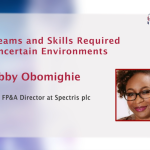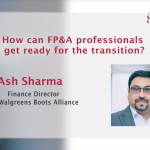FP&A is getting more and more relevant in the organisations as a key role to support...
The top 7 trends shaping FP&A today can be grouped into 3 key building blocks: Process, Technology, and People.
The building blocks are a 3-part recipe to create the perfect cake. Each part will help to curate a strong finance professional and a successful cross-functional FP&A team.
All 3 blocks are vital to run a successful FP&A operation – a consensus the entire group aligns with. There are times when one block takes precedence over the others. In this article, we explore the trends within each building block, and how they all interact, as discussed in a recent FP&A Trends Webinar.
The event panel consisted of: Larysa Melnychuk – Founder and CEO of FP&A Trends Group & International FP&A Board. Michael Weiss – VP Global Head of Business Value and Strategy at Anaplan. Michael Coveney – Analytics Thought Leader, Author and Head of Research at FP&A Trends Group.
The Building Block Trends
The 3 building blocks to a strong FP&A organisation are Process, Technology, and People. These 3 blocks consist of 7 "top trends".

Figure 1
Process
In a poll, 75% of voters agreed that the entire process of managing alternate scenarios is too long. Only 18% of voters can run simulations in a day or less. The consensus is that even "a day or less" is too long for scenario management. Where has this increased demand for instant answers come from?
How can leaders achieve “real-time” scenario management? Through clear harmonisation of the strategic plan, financial plan, and operational plan. Harmonisation is best achieved in lean and matrix-style org structures. These structures create less room for bureaucracy to delay key decision-making. This paves the way to harness “real-time” scenario management.
If companies focus efforts on developing a strong workforce then this will help to curate well-defined processes. Hire well, and trust your people to execute. A “real-time” planning process benefits from this type of trust.
Technology
Data. Big data. “So much data” as Michael Coveney, Analytics Thought Leader, Author and Head of Research at FP&A Trends Group, puts it. It is difficult to achieve a “real-time” planning process without quality data. Once we have quality data, we must invest in quality infrastructure to store and access it. Companies often use technologies provided by Amazon Web Services (AWS) to achieve this at scale, for example.
The above is the ideal situation. the reality involves messy data. This messy data goes into good tools and produces bad outputs. Who end up being at fault? the tools.
What do we do with “The Messy Middle” as Michael calls it? How can FP&A teams create better forecasts if the data is garbage?
Machine Learning (ML) models can often produce higher forecast accuracy than traditional modelling, saving teams time and resources.
Michael describes ML as “a branch of AI that uses algorithms to build predictive functions that learn from the data being analysed”. There are 2 methods of ML: supervised learning and unsupervised learning.

Figure 2
Supervised Learning: Provide a model with sample data about flower species and their respective characteristics. The model can take this data to predict the species of a flower from a different, "unseen" dataset. it makes this prediction by "learning" how comparable the new flower is to its sample data.
Unsupervised Learning: The ML model will create its own output not based on any given prediction. We can illustrate this using 2 AI “Boxers”. Provide the boxers some details of what it means to be a “boxer”. The boxer will then identify patterns over millions of “generations” before finally learning how to fight. Imagine how a toddler first learns to crawl and then walk.
In both cases, the models require inputs. Imagine the inputs as “drivers”, and customer profitability as the output we want to find. First, identify the key drivers of profitability to generate a solid driver-based planning model. Second, execute a proof-of-concept in Excel. Third, invest in ML technology to generate predictions.
ML is exciting but does this mean Excel is dead? – No. Technology is just an enabler. No one technology has all the answers. Invest in understanding the problem and deploying the right technology to solve it.
Let's illustrate a simple example of deploying technology based on the problem
1. Excel - Use historical data to identify a few drivers. Run basic correlation plots to rank them in order of strength
2. Python/R - Import datasets and use ML algorithms to produce a sales forecast prediction. This can be for n-years into the future
3. Either:
Excel - Import predictions into Excel and produce data tables to present to leadership
Python/R/PowerBI - Use data visualisation libraries to create data tables, and plot visuals that tell the story
Note: We can execute this same example all within PowerBI or R or Python too.
People
Tools include VBA, Python, R, PowerBI, MySQL, etc. Learn as many as you want. It will always still boil down to this basic question:
Are you able to use these tools to communicate key messages to stakeholders?
This introduces large-scale competition for talent. Strong finance skills are not “enough” anymore. A well-rounded finance professional must be able to analyse complex and unstructured data. The professional must also understand how to leverage and communicate to leadership. The message is that, strong hard skills are meaningful only with the ability to engage leadership in strategic decision-making

Figure 3
Conclusion
The webinar concluded with a polling question:
“How can FP&A organisations work toward achieving advanced skills maturity? How should they structure their teams?”
Take 1 hour with your team to discuss what “advanced skills” means to you and them. Then work backwards to what “basic skills” are pre-requisite to this.
Before getting your hands dirty in new and exciting ways of analysing data, assess if the basics are secure. One way to classify "basics" is as follows:
Process - The ability for a team to manage "real-time" change in forecast scenarios
Technology - Excel and power query
People - Can your empower your leaders to make data-driven decisions?
We thank our global sponsor Anaplan for their great support with this FP&A Trends Webinar.
Subscribe to
FP&A Trends Digest

We will regularly update you on the latest trends and developments in FP&A. Take the opportunity to have articles written by finance thought leaders delivered directly to your inbox; watch compelling webinars; connect with like-minded professionals; and become a part of our global community.





